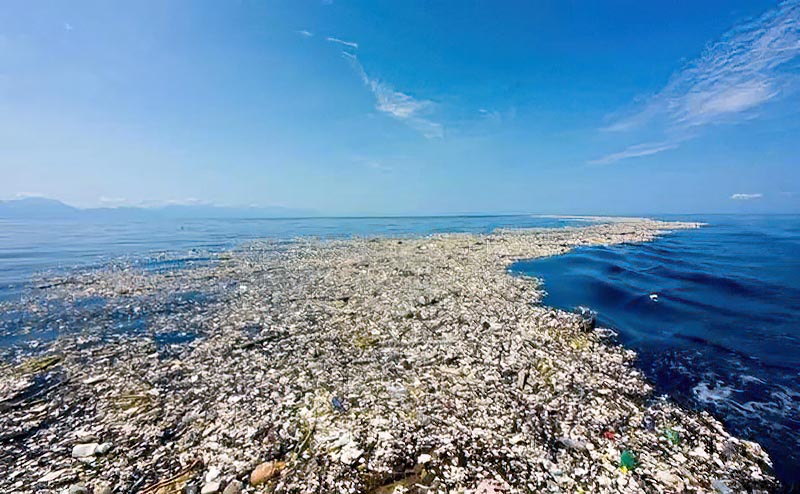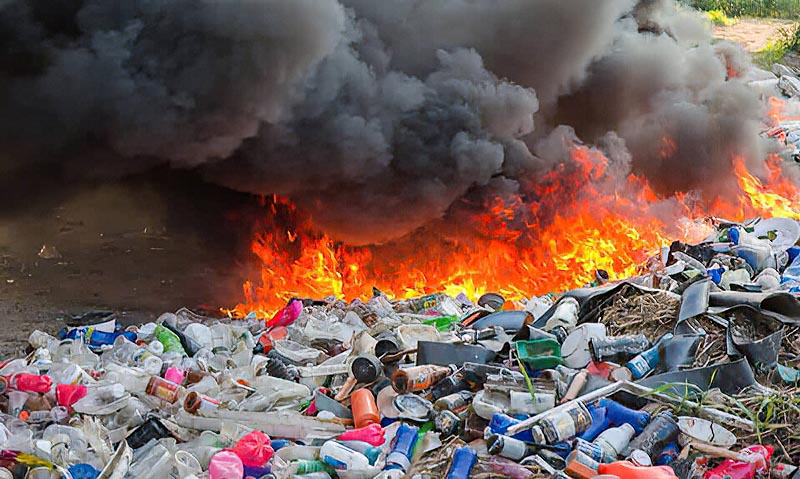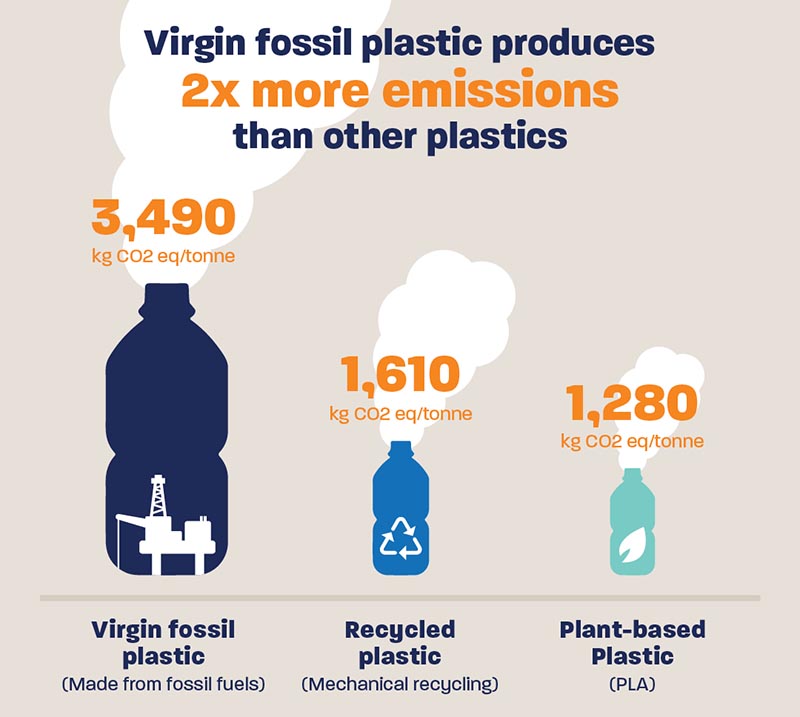

NEWS THAT MATTERS
Destroying our world with plastic
We're surrounded by plastic. It’s in the single-use packaging we discard, the consumer goods that fill our stores, and in our clothing, which sheds microplastic fibres in the wash. Much of it ends up in landfills, where it may take up to 1,000 years to degrade, leaching potentially toxic substances into the soil and water.
Plastics pollution has a direct and deadly effect on wildlife. Thousands of seabirds and sea turtles, seals and other marine mammals are killed each year after ingesting plastic or getting entangled in it.

A sea of plastic - the great Pacific garbage patch, which spans the waters from the West Coast of North America to Japan.
19 July 2023
ALAN HAYES
BEEP! BEEP! BEEP! The clock alarm shakes you from sleep. You stumble to the shower, dress, brush your teeth, and run a comb through your hair. There’s just enough time to grab a cereal bar, to eat on the way to work or school, and a bottle of orange juice before you rush out the door.
You’ve been awake for barely an hour, but you’ve already used or touched plastic dozens of times. The material is a huge part of our lives; it’s in everything from electronics and food packaging to medical devices and airplanes. Most plastic is human-made, produced using oil and other fossil fuels.
What makes plastic so popular? Unlike natural materials such as wood and glass, plastic is lightweight. It’s also cheap and durable.
But the very qualities that make plastic so useful to us also make it incredibly dangerous to the environment. Plastic doesn’t just go away. Instead, it breaks down into tiny pieces over time. And those pieces will stick around for hundreds—or perhaps even thousands—of years.
For decades, people have sipped from plastic straws and toted groceries in plastic bags without a second thought. And all that plastic—much of it used only once—has added up. Worldwide, we’ve produced a staggering 9.2 billion tons of plastic since the 1950s. By 2050, it’s estimated that we’ll have created 13 billion tons of plastic waste.
Yet I can still remember a time, and it wasn’t that long ago, before plastic had taken over our world; the same consumer goods we buy today were still available and people took their own shopping bags to the supermarket or corner grocery store – using a plastic carry bag wasn’t an option, and it doesn’t have to be today.
As an author, who has written numerous run-away best-selling books on living an environmentally sustainable lifestyle, I find it hard to comprehend the insatiable appetite for plastics – considering most people understand that plastic is killing our planet. But it’s not just our wildlife that is in danger, plastics are polluting our atmosphere too!
New research commissioned by the Australian Marine Conservation Society (AMCS), which is the voice for Australia’s oceans, and World Wildlife Fund Australia (WWF) has finally revealed the hidden climate cost of Australia’s plastics addiction, and the results are shocking.

Scientists have found that burning plastic is also polluting our air..
In 2020, Australia’s plastics use produced more than 16 million metric tonnes of greenhouse gas emissions (GHG). That’s equivalent to 5.7 million cars on the road every year.
While Australia doesn’t make a lot of plastic - 87% of the plastic we use is imported - we generate more single-use plastic waste per person than any other country, except Singapore.
If we continue on our current path, the emissions from Australia’s plastic use are expected to double by 2050. Globally, emissions from plastics could account for up to 15% of the world’s carbon budget by that same year, if action isn’t taken immediately to end the plastic addiction.
The worst plastic offender is Virgin Plastic! Virgin plastic is any plastic resin newly produced from petrochemicals, such as natural gas or crude oil.
The term virgin refers to the fact it has never been used previously and is therefore not recycled plastic.
Many industries, such as the medical, healthcare and food packaging industries, rely heavily on the use of disposable virgin plastics. Because of this, virgin plastic production will never be phased out or replaced until a better alternative is invented.
The non-renewable natural resources used to produce ‘virgin plastic’ are in short supply and large amounts of energy are consumed to refine it. The pollution emitted into the environment also needs to be considered when evaluating plastic usage. Finally, most it ends up in landfill or is discarded in our natural environment.
Virgin plastic is not biodegradable and cannot be considered to be sustainable or environmentally friendly.

Is recycling plastic the answer?
Research has shown that chemical recycling (using chemical processes to turn plastic into oil) is 67% more emissions intensive than traditional mechanical recycling.
Chemical recycling is an environmental health risk. Plastics contain toxins, and heating plastics creates even more. All of those toxic substances must go somewhere—into the air, the water, and the final products.
Pyrolysis, the most commonly used chemical recycling technology, produces more emissions than waste incineration.
Industry has grossly overstated the feasibility of chemical recycling and understated its emissions. The lack of robust independent reporting and monitoring of chemical recycling facilities has led to it being portrayed well above and beyond its capabilities.
Chemical recycling has a large carbon footprint and poses a climate risk. In the chemical recycling process, more plastics are turned into greenhouse gas emissions than back into plastics.
The simple fact is that chemical recycling will not solve the plastic crisis. Even with the most advanced plastic-to-plastic technologies available at present, very little of end-of-life plastics actually become new plastics. Most is lost in the process, so it cannot qualify to be part of a circular economy.
And where does plastic incineration fit into the climate problem?
Plastic incineration or burning waste to create energy are the most emissions intensive disposal methods for plastic – it is the hidden climate cost of plastic in Australia.
Burning plastic can generate and release pollutants like microplastics, bisphenols, and phthalates and toxic gases like dioxins, furans, mercury and polychlorinated biphenyls (better known as BCPs) into the atmosphere, and poses a threat to vegetation, and human and animal health — all toxins that can disrupt neurodevelopment, endocrine, and reproductive functions.
When plastics are burned, dioxins settle on crops and in our waterways, where they eventually enter our food and hence our bodies. These dioxins are potentially lethal persistent organic pollutants that can cause cancer and disrupt thyroid and respiratory systems.
Phthalates, the very chemicals that give plastic their desirable qualities—flexibility and softness—are endocrine disruptors, associated with a plethora of health problems, from fertility issues and neonatal impacts on babies to allergies and asthma.
Burning of plastic waste increase the risk of heart disease, aggravates respiratory ailments such as asthma and emphysema and cause rashes, nausea or headaches, and damages the nervous system.
Burning plastic also releases black carbon (soot), which contributes to climate change and air pollution.
How does plastic contribute to global warming?
Throughout their lifecycle, plastics have a significant carbon footprint and emit 3.4% of global greenhouse gas emissions. Beyond the hazards posed to the marine and terrestrial environment as well as to humans, plastics are also a substantial contributor to global greenhouse gas emissions. In 2019, plastics generated 1.8 billion tonnes of greenhouse gas (GHG) emissions – 3.4% of global emissions – with 90% of these emissions coming from their production and conversion from fossil fuels. By 2060, emissions from the plastics lifecycle are set to more than double, reaching 4.3 billion tonnes of GHG emissions.
Furthermore, airborne microplastics have been found in remote regions, including the Arctic, where they may contribute to accelerated warming through absorbing light and decreasing the surface albedo of snow.
So, what is the answer?
We need urgent action to address the global plastic pollution epidemic.
Unfortunately, plastic is so durable that the EPA reports “every bit of plastic ever made still exists.” All five of the Earth's major ocean gyres are inundated with plastic pollution. The largest one has been dubbed the Great Pacific Garbage Patch.
However, solving the plastic problem is not so complicated. The solution is to use less plastic, more recycling and more renewable energy – the use of renewable energy in manufacturing is important.
Dominic Zaal, Director of the Australian Solar Thermal Research Institute (ASTRI), said that concentrated solar thermal power (CSP) can help industry to achieve the renewal energy goal in manufacturing.
Mr. Zaal is currently supervising a project for Mars Foods in Victoria where not only will CSP provide electricity but the heat captured will be used in the manufacturing process. A technology that works, does not emit CO2 or toxins and is environmentally safe, and is the way of the future.
CSP is a tool that can be used to power recycling with clean, renewable energy, and to replace virgin fossil fuel plastics with recycled or plant-based plastics.
Yet until we have strong, binding laws that make companies responsible for reducing plastic and increasing recycling in Australia, we will continue to aid in destroying our world with plastic.


SUBSCRIBE FOR FREE to the Grapevine News Online and to the monthly e-book edition of the Grapevine Community News. You will receive an email notification every time a news story goes live, keeping you up to date with what is happening in your community.
Our online news platform and monthly newspaper is about real local news and events. We will not spam you or share your details with third parties.








%20advert.jpg?crc=3763325189)









